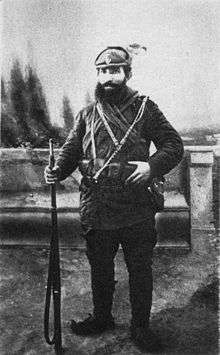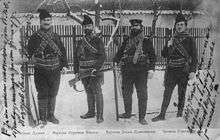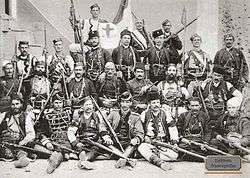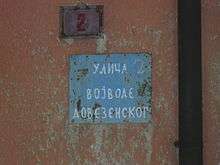Jovan Dovezenski
Jovan Stanojković (Serbian Cyrillic: Јован Станојковић, 8 April 1873 – 2 May 1935), known by his nom de guerre, the demonym Dovezenski (Довезенски), was a Serbian Chetnik commander (vojvoda), and participant in the Balkan Wars, in the Battle of Kumanovo, and World War I.[1] He was originally a teacher who turned into a guerilla fighter following Bulgarian oppression on Serb people in Macedonia. He rose in ranks and became one of the supreme commanders in Macedonia.
Vojvoda Jovan Dovezenski | |
|---|---|
 Dovezenski in Chetnik gear | |
| Birth name | Jovan Stanojković |
| Nickname(s) | Dovezenski |
| Born | April 8, 1873 Dovezence, Ottoman Empire (now Kumanovo Municipality, R. Macedonia) |
| Died | May 2, 1935 (aged 62) Kumanovo |
| Allegiance |
|
| Years of service | 1904–1918 |
| Rank | vojvoda |
| Military history | Chetnik Action, Balkan Wars, World War I |
Early life
He was born on April 8, 1873, in Dovezence near Kumanovo,[2] at the time part of the Kumanovo kaza of the Sanjak of Üsküp, Ottoman Empire (now R. Macedonia). He belonged to the Velčevci family.[3] He went to primary school in the nearby village of Murgaš, and in the Gradište Monastery, where they taught in Old Slavonic.[4] By the time of the Serbo-Bulgarian War (1885), he had finished all schools possible in his home region.[4] In 1888, he moved to the Principality of Serbia, for further education.[4] He entered the theological teacher school of the Society of St. Sava, available to youngsters from Old Serbia and Macedonia.[4] Jovan Babunski, a future fellow Chetnik, also went to the same school,[5] among others.[6] In 1897 he became a teacher in his home village.[4] He remained a teacher until March 3, 1904, when he joined the Serbian Chetnik Organization.[4]
Chetnik Organization
Pavle Mladenović established the first local Serb-oriented cheta (band) in Kumanovo[7] in springtime 1903 when the Internal Macedonian Revolutionary Organization (IMRO) started assassinating and murdering people who identified themselves as Serbs in the Kumanovo region.[8][9] After Mladenović, Jovan Stanojković, who had been a teacher up until then in Rudar,[10] formed a band in the Kumanovo region.[11] He adopted the nom de guerre "Jovan Dovezenski".[12] Dovezenski spontaneously decided to command his own band after Bulgarian commander Atanas Babata massacred Serbs in his village on 11 August 1904.[10] After the establishment of bands in Kumanovo, self-organized bands were established in Skopska Crna Gora and in the Palanka kaza.[13] All of these bands had the objective of self-defense, and they worked independently from one another.[13] In the summer of 1904, resistance to the Bulgarian oppression emerged with the first Serbian-organized secret band in Drimkol, led by Đorđe Cvetković-Drimkolski from Labuništa.[13] Henceforth, the movement was coordinated.[13]
The left side of the Vardar was formed out of locals in the bands of Pavle Mladenović, Dovezenski, and Petko Ilić.[14] Ilija Jovanović, Ljuba Jezdić and Đorđe Skopljanče were among those sent by the Committee across the border.[14] On the night of 22–23 October 1904, Dovezenski's band attacked the village of Beljakovce, where he, according to the Bulgarian sources, killed Bulgarian Exarchist teacher Teodosi Sholyakov, one other man and two women.[15] In November 1904, Dovezenski came to Vranje where he formed a band, in which, among others, were two youngsters, both from Peć: a border gendarmerie corporal, Kosta Pećanac and a lance sergeant from the NCO school, Đorđe Skopljanče.[16] Dovezenski proved to be a capable organizer and propagandist, and thanks to him, the Chetniks were joined by the bands of Ilinden veteran commanders Krsta Kovačević, Vanđel Skopljanče and Milan Štipljanče.[17]
He organized the Board of Western Povardarje in 1904.
 Micko and Dovezenski in the centre, 1904–05
Micko and Dovezenski in the centre, 1904–05 Micko and Dovezenski, 1904–05
Micko and Dovezenski, 1904–05 Group photo of Chetnik commanders, during the Young Turk Revolution (1908).
Group photo of Chetnik commanders, during the Young Turk Revolution (1908). Dovezenski, sitting in the centre, with fellow Chetnik commanders, during the Young Turk Revolution (1908).
Dovezenski, sitting in the centre, with fellow Chetnik commanders, during the Young Turk Revolution (1908). Portrait of Dovezenski, wearing a fez, coat jacket, and white ribbon (1908).
Portrait of Dovezenski, wearing a fez, coat jacket, and white ribbon (1908).
Balkan Wars
After unsuccessful fights with Bulgarian bands, Komenović was replaced with Dovezenski.[18] He participated in the Battle of Kumanovo.
World War I
Later years
He was a minister of the National Assembly.[19]
There is a story about Jovan Dovezenski and Deda-Laza Aleksić, both widowers, who were interested in the same widow at a party. Dovezenski first took her to dance, then Aleksić danced with her, better and longer, however, the widow chose Dovezenski.[20]
He died on 2 May 1935 in Kumanovo.[2] His descendants, as those of Jovan Babunski, are surnamed with their Chetnik surnames.[12]
One of his descendants is Nebojša Dovezenski, a researcher and molecular immunologist.
Awards
Legacy

A street in Zvezdara, Belgrade is named after him (ul. Vojvode Dovezenskog).
Annotations
- His surname is scarcely spelled Stojković (Стојковић).
References
- Д. С. Јеринић (2008). "Војводе из четничке акције у Старој Србији и Маћедонији 1903-1912". Добровољачки гласник, бр. 32. година 17: 28–29.
- "Српски биографски речник, том 3" (PDF). Нови Сад: Матица српска. 2007. Cite journal requires
|journal=(help) - Jovan F. Trifunoski (1974). Kumanovska oblast. Trifunoski. p. 184.
Пред крај поменуте владавине у овом селу истакао се познати четнички војвода Ј о в а н Станојковић — Довезенски. Потицао је од рода Велчевци.
- Prvo jugoslovensko narodno pretstavništvo izabrano 8.nov.1931.godine. 1931. p. Јован С. Довезенски рођен је 8. априла 1873. у селу Довезеиима, срез жеглиговски. Основну школу учио је у селу Мургашу и у Градишком Манасти- ру, где се је учило старословенски. У време српско - бугарског рата г. Довезенски је свршио и остале школе до ко- јих се, у то време, у његовом родном крају могло доЬи. 1888. год. прешао је у Србију, да продужи школу. Уписао се у Светосав- ску богословско-учитељску школу за младиЬе из јужних крајева. 1897. постао је учитељ у свом родном месту. На тој дужности остао је до 3. марта 1904., ка-да је ступио у Комитет српске четничке организације, а на томе послу остао је све до ослобођења Јужне Србије, 1912. године. Г. Довезенски је организатор првих наших четничких ...
- Spomenica Drustva Svetoga Save, 1886-1936. Drustvo Sv. Save. 1936. p. 35.
- Božidar S. Nikolajević (1986). Iz minulih dana: sećanja i dokumenti. Srpska akademija nauka i umetnosti. p. 9.
- Jovan Jovanović; Stanoje Stanojević (1935). Srpski narod u XIX veku [Serbian People in the 19th Century] (in Bosnian). Izdavačko i knjižarsko preduzeće G. Kon a.d.
- U. Šešum, Vojvode srpske četničke organizacije 1903-1908, Naša Prošlost br. 11, Kraljevo 2011, 136.
- Narodna enciklopedija srpsko hrvatsko slovenačka, Beograd 1929, 836-837
- Jovanović 1937, p. 289.
- Jovan Jovanović; Stanoje Stanojević (1935). Srpski narod u XIX veku [Serbian People in the 19th Century] (in Bosnian). 16. Izdavačko i knjižarsko preduzeće G. Kon a.d. p. 158.
Прву чету је органи- зовао Павле Младеновић из кумановског села Јачинца. За њим је образовао чету мирни учитељ Јован Станој- ковић из кумановског села Довезенаца, доцније познати војвода Довезенски. Из кумановског ...
- Recueil de Vardar. Akademija. 2006. p. 99.
- Đurić & Mijović 1993, p. 33.
- Jovanović 1937, p. 288.
- Svetlozar Eldŭrov (1993). Srŭbskata vŭorŭzhena propaganda v Makedonii︠a︡, 1901-1912. Voennoizdatelski kompleks "Sv. Georgi Pobedonoset︠s︡". p. 122.
- Trbić 1996, p. 68.
- Ilić, Vladimir (March 4, 2003). "Srpski četnici na početku dvadesetog veka (6): Pogibija na šupljem kamenu". Glas Javnosti.
- Milan Milošević; Branko Bogdanović (2004). Bezbednost obnovljene Srbije. Službeni glasnik. p. 65.
- Miladin Pećinar (1969). Skopski đački bataljon 1914: Bataljon 1300 kaplara. Udruženje 1300 ̋kaplara. p. 23.
- Ljubica S. Janković; Danica S. Janković (1951). Narodne igre. Skupile i opisale Ljubica S. Janković i Danica S. Janković. Štamparija D. Gregorića. p. 54.
Sources
- Đurić, Veljko Đ.; Mijović, Miličko (1993). Ilustrovana istorija četničkog pokreta.CS1 maint: ref=harv (link)
- Hadži Vasiljević, Jovan (1928). Četnička akcija u Staroj Srbiji i Maćedoniji.
- Ilić, Vladimir (2006). Српска четничка акција 1903-1912. Ecolibri. ISBN 978-86-7905-044-1.
- Jovanović, Aleksa (1937). Spomenica dvadesetogodišnjice oslobodjenja Južne Srbije, 1912-1937. Južna Srbija.
- Krakov, Stanislav (1990) [1930]. Plamen četništva (in Serbian). Belgrade: Hipnos.
- Trbić, Vasilije (1996). Memoari: 1898-1912 (in Serbian). Kultura.